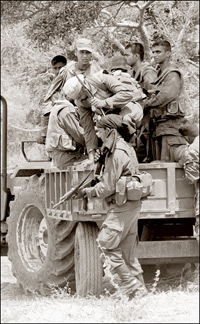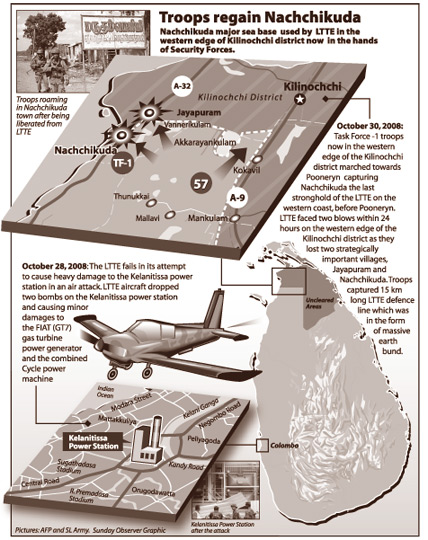LTTE hopes diminish after losing key defence line
by Ranil WIJAYAPALA
 Whatever
hope the LTTE had of clinging on to their future operations, it had all
diminished this week having lost their key defence line which helped
them to keep the Security Forces at least a few Kilo metres away from
their de-facto capital Kilinochchi. Whatever
hope the LTTE had of clinging on to their future operations, it had all
diminished this week having lost their key defence line which helped
them to keep the Security Forces at least a few Kilo metres away from
their de-facto capital Kilinochchi.
After months long war of attrition waged by the military on one of
the major LTTE defence lines covering the boundaries of the Kilinochchi
District, positive results have been achieved as troops were able to
completely capture the ditch cum earth bund from Nachchikuda in the
Western edge to Akkarayankulam in the East.
The capture of Nachchikuda, the last LTTE stronghold on the Western
coast before Pooneryn and the heavily fortified Akkarayan tank bund were
the last stretch of defences to fall, complet the full capture of this
defence line created by the LTTE to delay the advance of the troops into
its strongholds.
|

Pic:Rukmal Gamage |
It was a significant, achievement for the troops now operating in the
Western edge of the Kilinochchi District in the West of A-9 Road as it
was the major obstacle they faced in their forward march to Northwards.
It was exactly three and half months back that the troops attached to
the Task Force -I or the 58 Division first detected this barrier as they
moved into the Mulangavil town on the Mannar Pooneryn Road 35 Km North
off Mannar after capturing many of the LTTE strongholds including the
Mannar 'Rice Bowl', Viddattaltivu Sea Tiger Base, Illuppakadavai and
Vellankulam within one and half months.
Though it was initially observed as yet another earth bund similar to
that of the earth bunds the LTTE had constructed in Mannara Rice Bowl
area, in Viddattaltivu, and Vellankulam, the follow up observations
confirmed that it was extending upto Akkarayankulam tank bund.
This massive defence line had been constructed by the LTTE using the
heavy earth moving equipment belonging to the INGOs and NGOs operating
in Kilinochchi District and linking the tank bunds available in the area
such as Pandiveddikulam, Vannerikulam and Akkarayankulam.
 A number of attempts made by the Task Force -I troops and the 571
Brigade troops in mid September ended with a higher number of casualties
and deaths among the troops as LTTE strongly defended this earth bund
bringing reinforcements even from the Muhamalai front. A number of attempts made by the Task Force -I troops and the 571
Brigade troops in mid September ended with a higher number of casualties
and deaths among the troops as LTTE strongly defended this earth bund
bringing reinforcements even from the Muhamalai front.
However, the Task Force I or 58 Division troops made a major
breakthrough after capturing nearly one kilometer stretch of this earth
bund from Karambakulam North East of Nachchikuda amidst stiff resistance
from the LTTE.
That was the turning point for the troops in their bid to overcome
this obstacle and advance further Northwards. The troops of the Task
Force I under the command of Brigadier Shavendra Silva moved further
Northwards from the stretch of the earth bund they captured in
Karambakulam and cutting off Nachchikuda - Kokavil Road further
isolating Nachchikuda Sea Tiger base from the Western flank.
It was amidst observances by the forward domination troops that the
LTTE was extending this earth bund towards A-9 from the East of
Akkarayankulam, and troops of the 572 Brigade suddenly moved into
Akkarayankulam East and towards Murikkandi and Kokavil amidst stiff
resistance from the LTTE bringing the Forward Defences of the Security
Forces just two Kilometers South of the Kilinochchi border.
After this move by the 572 Brigade which was under the command of
Colonel Senerath Bandara, the Task Force I troops continued to expand
their control over this earth bund in the West of Vannerikulam and in
the East of Pandiveddikulam which is located some seven Kilometers North
East of Nachchikuda.
It was on October 18 that troops attached to 571 Brigade under the
command of Colonel G.V. Ravipriya and the 582 Brigade under the command
of Lt. Colonel Sanjay Wanigasinghe initiated the task of completely
capturing the earth bund from Vannerikulam to Akkarayankulam with the
entire section taken under troops control by October 22.
By this time columns of troops from the 583 Brigade and 581 Brigade
started to move Northward and hit the A-32 Road from 10 Km North of
Nachchikuda encircling the Jeyapuram village to the South which was
strongly hold by LTTE as it gave a depth for them to defend their last
stronghold in the Western coast.
But the LTTE's long drawn plans to defend the massive fishing village
became futile with the capture of Jeyapuram village by the Task Force I
troops in a surprise move on Wednesday. As columns of troops attached to
10 Gajaba Regiment captured Jeyapuram village, the troops attached to
the 581 Brigade under the command of Lt. Colonel Deshapriya Gunawardena
overan the Nachchikuda defence from the South.
Troops attached to 12 Gajaba Regiment, 5 Signal Corps and 11
Artillery Regiment moved into Nachchikuda village by Wednesday (October
30) evening passing a major milestone in their march towards Pooneryn.
They completely captured Nachchikuda by Thursday evening.
By this time the troops attached to 571 Brigade operating in the West
of Akkarayankulam tank linked up with the 572 troops operating in the
East of Akkarayan tank completing the task of capturing the entire earth
bund under Security Forces control and entering into the tactically
important Akkarayan village which act as a buffer zone to defend
Kilinochchi town.
The capture of Nachchikuda the last biggest fishing village in the
Western coast and the capture of Akkarayankulam tank bund were the last
stretch of defences to fall to the troops and the Task Force -I troops
under the command of Brigadier Shavendra Silva is now marching further
Northward and short by only 15 Km to reach strategically important
Pooneryn town from which troops can link up with troops in Jaffna via
Sangupiddy Jetty.
Troops of the Task Force -I were in the process of capturing
Vallaipadu, the last unloading point the LTTE is having in the Western
coast to smuggle in their supplies from the South Indian coast to the
Western coast.
It was amidst these efforts by the Security Forces that the LTTE once
again came up with their popular tactics to bring attention towards them
as the big cries about the LTTE became suddenly silent even in the Tami
Nadu politics following Senior Presidential Advisor and MP Basil
Rajapaksa's high profile visit to India over the last weekend.
His discussions with Indian External Affairs Minister Pranab
Mukherjee brought positive results over the Sri Lankan issue, silencing
the agitation campaigns by Tamil Nadu politicians demanding an immediate
Ceasefire.
That might be the worrying factor for the LTTE to send two of its
light aircraft to Mannar and Colombo to drop few of its crude bombs
targeting the Mannar Area headquarters in Talladi and Kelanitissa Power
Station in Colombo.
This light aircraft has been first detected by the radars installed
in Vavuniya at 10.18 p.m. However, it has not yet been confirmed whether
it was the same light aircraft which had dropped bombs on the Talladi
camp and Kelanitissa Power Station as there are conflicting reports
about the number of aircraft engaged in these air raids.
It was on Tuesday around 10.35 p.m. one Tiger light aircraft dropped
three bombs into Sri Lanka Army Headquarters in Thalladi, Mannar causing
minor damages to the camp site and injuring three soldiers who were in
the open area inside the camp.
Non of the military equipment inside Thalladi camp were damaged in
the air raid though LTTE tried their best to target long range artillery
or Multi Barrel Rocket Launchers which could have been installed there
through this air raid, as they mentioned in the pro-LTTE Tamilnet
website.
Few minutes after the Mannar air raid, the ground troops operating in
Thunukkai and Mallavi reported that they heard the sound of the light
aircraft returning towards Iranamadu direction. However, there is no
such indication on SLAF radars about such air movement, according to Air
Force.
Few minutes after the Mannar air raid, the electricity supplies were
disconnected in Colombo city and suburbs as the radars in Palavi
detected another light aircraft heading towards Colombo. By this time
Kfir fighter jets and F-7 interceptors were airborne from Katunayake and
Colombo ready with anti air craft guns.
From its first detection, the aircraft had disappeared from the radar
screen from time to time as it was flying just 300 feet altitude.
However, it had come towards Colombo from the sea side and entered into
land area from the edge of the Colombo Harbour.The powerful cameras
installed at the Colombo Harbour had videoed the clear movements of the
Tiger aircraft which was flying at low altitude so that radars cannot
easily detect it and troops on the ground could not direct their anti
air craft guns towards it as it was flying so low.
According to experts anti aircraft guns are installed to be directed
towards high flying objects and it is difficult to maneuver these guns
to direct at low flying objects.The sky in the Colombo city turned into
a firework display with the air defence systems installed at all vital
installations activated once as the aircraft was heading towards Colombo
city.
The aircraft, which came from sea side turned towards the Kelanitissa
Power station from the edge of the Colombo harbour and dropped two bombs
into the power station amidst firing directed it from various locations
at from Colombo Harbour, World Trade Centre and all other vital
installations in Colombo.
A huge smoke emanated from the Kelanitissa power station soon after
the air raid and caused minor damages to FIAT (Gas Turbine 7) and the
Combined Cycle Power Plant. Fire fighting vehicles were rushed to the
scene soon after the notice of the small fire and the situation was
brought under control ten minutes later.
The LTTE light aircraft which dropped two bombs onto the Kelanitissa
Power Station, took its return path from the land side to a certain
extent and stuck to the sea route and had returned to uncleared areas
from the North of Mannar.
However, the F-7 interceptors which were airborne from Katunayake,
though detecting the Tiger aircraft could not take the target due to
technical reasons. According to experts and those who observed the light
air craft, the LTTE aircraft had arrived towards Colombo covering its
engines with armour plates so that the heat is not released outside the
engine avoiding the seeking missile system on the F-7 interceptors to
lock the target to release the heat seeking missile to destroy the
target.
To release the missile the missile system had to lock the target.
It is also believed that it was due to these heavy armour plates that
the Tiger aircraft had taken more than one hour to reach Colombo and
taken a similar period to return to either Iranamadu or Mullaitivu after
dropping two bombs onto Kelanitissa Power Station.
However, the incident confirms the destruction of the LTTE aircraft
which was returning after dropping two bombs on Wanni Security Forces
Headquarters few weeks back. Because, they have taken precautionary
steps to avoid such a repetition this time by covering its engines with
heavy armour plates as they were aware was to why their aircraft got
caught to the SLAF missile attack.
Though, the LTTE could not cause bigger damage through their air
raids, the seventh air raid since April 2007, once again it managed to
draw the attention of the media worldwide, which is the need of the day
for the LTTE at this desperate moment.
But it was not the end of their desperate bids. Last morning they
made yet another desperate bid launching three flotillas of boats from
Thalaiadi around 5.30 yesterday.
This Tiger boat movement was soon detected by the Naval troops and
they launched their small boats squadrons to confront them in the sea
off Nagarkovil.
After nearly a one hour battle, Naval troops were able to destroy
four of their boats.
Out of the four boats two boats, which were suspected to be suicide
boats, were exploded killing 14 Sea Tiger cadres including four Black
Tigers.
The SLAF gunship helicopters also gave chase to the retreating boats
and destroyed two Tiger boats as they were landing in Championpattu
area. It has been confirmed that senior Sea Tiger leader 'Lt. Colonel'
Kannan, who commanded this sea battle was also killed in the attack.
These desperate bids by the LTTE very clearly reflects that they are
now in a confusing situation and making all their desperate attempts to
cover up their humiliating and certain defeat now looming in Wanni. |

